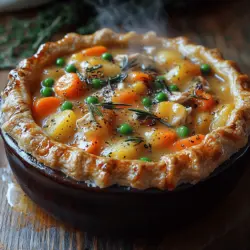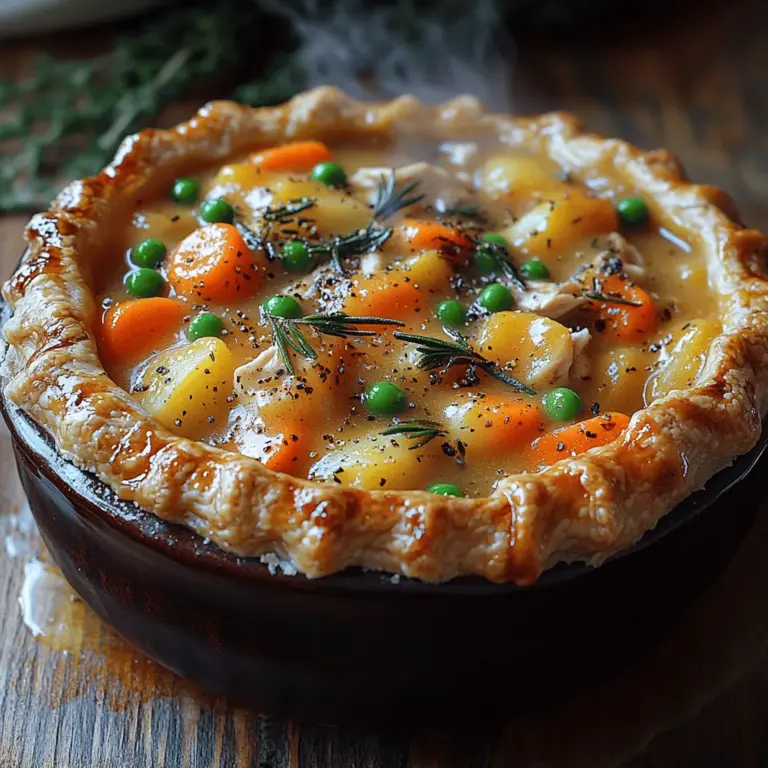Introduction to Tender Rosemary Chicken Pot Pie
In the realm of comfort food, few dishes rival the warmth and satisfaction of a freshly baked chicken pot pie. This classic recipe, infused with fragrant rosemary, encapsulates a medley of flavors and textures that can delight any palate. The combination of tender chicken, seasonal vegetables, and a creamy sauce, all enveloped in a flaky, golden-brown crust, makes this dish a timeless favorite. Whether you’re hosting a gathering or enjoying a cozy family dinner, Tender Rosemary Chicken Pot Pie is a dish that brings everyone to the table.
The origins of chicken pot pie can be traced back to ancient times when the concept of encasing meat and vegetables in pastry was a practical solution for preserving leftovers. Over the centuries, this dish has evolved into a beloved staple in many households, particularly in American cuisine, where it has been adapted to suit regional tastes and seasonal ingredients. The addition of rosemary not only enhances the flavor profile but also pays homage to the herb’s long history in culinary traditions, known for its aromatic qualities and health benefits.
As we embark on the journey of creating the perfect Tender Rosemary Chicken Pot Pie, it’s essential to understand the key components that make this dish a standout. From selecting the right ingredients to mastering the baking technique, we will provide you with a comprehensive guide that ensures your pot pie turns out perfectly every time.
Understanding the Ingredients
To create a truly memorable chicken pot pie, it’s crucial to pay attention to the ingredients. Each component contributes to the overall flavor and texture, making the dish not only delicious but also satisfying. Let’s explore the essential elements that come together to make this pot pie a culinary delight.
Exploring the Essential Components of the Filling
The Role of Chicken: Choosing the Best Cuts for Flavor
The heart of any chicken pot pie is, of course, the chicken itself. For the best flavor and tenderness, opt for bone-in, skin-on chicken thighs. These cuts are richer in flavor and remain juicy during cooking, providing a satisfying bite. If you prefer a leaner option, boneless, skinless chicken breasts can also work, but be mindful not to overcook them, as they can dry out.
Seasonal Vegetables: Carrots, Peas, and Potatoes
A perfect pot pie features a colorful medley of vegetables. Carrots, peas, and potatoes are traditional choices that not only add visual appeal but also a variety of textures. Carrots bring sweetness, peas add pop and freshness, while potatoes lend heartiness to the filling. Feel free to customize the vegetable selection based on what’s in season or your personal preferences—corn, green beans, and celery can also enhance the dish.
The Aromatic Base: Onions and Garlic
No savory dish is complete without a solid aromatic base. Onions and garlic are essential for building flavor in the filling. They should be sautéed until soft and fragrant, creating a foundation that elevates the other ingredients. The sweetness of caramelized onions balances the savory elements, while garlic adds depth and complexity.
Herbs that Elevate: The Importance of Rosemary and Thyme
Rosemary is the star of this pot pie, providing a fragrant, earthy note that complements the chicken beautifully. Fresh rosemary is ideal, but dried rosemary can also be used if fresh is unavailable. To enhance the dish further, consider adding a touch of thyme, which pairs wonderfully with chicken and adds a subtle herbal nuance.
Creaminess Factor: Heavy Cream vs. Alternatives
The creamy sauce is what makes a chicken pot pie truly indulgent. Heavy cream is the traditional choice, imparting richness and a velvety texture. However, for a lighter alternative, you can use half-and-half or even a combination of chicken broth and milk. Just be sure to adjust the seasoning accordingly, as lighter options may require a bit more flavor enhancement.
Balancing Flavors: The Importance of Seasoning
Seasoning is crucial in transforming simple ingredients into a delicious filling. Salt and pepper are fundamental, but don’t shy away from experimenting with other spices such as paprika, cayenne, or even a splash of lemon juice for brightness. Taste as you go to ensure that the flavors are well balanced and harmonious.
Examining the Pie Crust
The crust is just as important as the filling in a chicken pot pie. A good pie crust should be flaky, buttery, and sturdy enough to hold the rich filling without becoming soggy.
The Basics of a Good Pie Crust: Flour and Fat
A classic pie crust is made from just a few simple ingredients: all-purpose flour, butter (or another fat), salt, and water. The flour provides structure, while the fat creates flakiness. It is essential to use cold fat, as this helps create distinct layers in the dough.
The Science of Texture: Chilled Butter and Ice Water
Chilled butter is key to achieving the desired texture in your pie crust. When the butter is cold, it creates pockets of steam as it melts during baking, resulting in a flaky crust. Additionally, using ice water when mixing the dough helps keep everything cool and ensures that the fat doesn’t melt before it’s time to bake.
Enhancing Flavor: The Role of Salt in the Crust
Don’t overlook the importance of salt in your pie crust. A pinch of salt not only enhances the flavor of the crust but also balances the richness of the butter. Be sure to mix it evenly with the flour to ensure consistent flavor throughout.
Step-by-Step Preparation
Now that we have a solid understanding of the ingredients, it’s time to dive into the preparation process. Creating a Tender Rosemary Chicken Pot Pie requires a few steps, but with careful attention to detail, you’ll be rewarded with a delicious dish that’s worth the effort.
Mastering the Pie Crust
Mixing the Ingredients: Achieving the Right Consistency
Start by combining the flour and salt in a mixing bowl. Cut the chilled butter into small cubes and add it to the flour mixture. Using a pastry cutter or your fingertips, work the butter into the flour until the mixture resembles coarse crumbs, with some pea-sized pieces of butter remaining. This step is crucial for achieving a flaky texture.
Chilling the Dough: The Importance of Temperature
Once the butter and flour are combined, gradually add ice water, one tablespoon at a time, mixing gently with a fork until the dough begins to come together. Be careful not to overmix. Once the dough holds together, shape it into a disc, wrap it in plastic wrap, and refrigerate for at least 30 minutes. Chilling the dough allows the gluten to relax and the fat to firm up, making it easier to roll out later.
Rolling the Dough: Techniques for a Perfect Fit
After chilling, lightly flour your work surface and rolling pin. Roll out the dough into a circle about 1/8 inch thick, ensuring it’s large enough to fit your pie dish. To transfer the dough, gently roll it onto the rolling pin and unroll it over the pie dish. Trim any excess dough, leaving a slight overhang, as this will allow for crimping and sealing later.
Crafting the Savory Filling
Sautéing Aromatics: Building Flavor from the Base
While the dough is chilling, you can begin preparing the filling. Heat a large skillet over medium heat and add a tablespoon of olive oil. Once hot, add diced onions and minced garlic, sautéing until they are soft and translucent. This step builds an aromatic base that will infuse the filling with flavor.
Cooking Vegetables: Achieving the Right Tenderness
Next, add your chopped carrots and diced potatoes to the skillet. Cook for about 5-7 minutes, until the vegetables start to soften. Add peas towards the end of the cooking process, as they require less time to become tender. Stir in the chopped rosemary and thyme, allowing their fragrant oils to release into the mixture.
Incorporating Chicken: Ensuring Even Distribution
Once the vegetables are cooked, add your pre-cooked and shredded chicken to the skillet. This is where you can mix everything together and ensure that the chicken is evenly distributed throughout the filling.
Creating a Creamy Sauce: The Role of Chicken Broth and Cream
To create the luscious sauce, pour in chicken broth and heavy cream, stirring until combined. Let the mixture simmer for a few minutes, allowing it to thicken slightly. Taste and adjust seasoning with salt and pepper as needed, ensuring the filling is flavor-packed and ready to shine.
In the next section, we will cover the final steps of assembling the perfect pie, including how to create a beautiful top layer and the best baking techniques to achieve that golden crust. Stay tuned for more delicious details on creating a show-stopping Tender Rosemary Chicken Pot Pie that will leave everyone wanting seconds.
{{image_2}}
Adding the Top Crust
Rolling and Positioning: Ensuring a Secure Seal
After preparing your savory filling, it’s time to focus on the top crust, which is crucial for sealing in the delicious flavors of the chicken pot pie. Begin by rolling out your chilled pie crust on a lightly floured surface. Aim for a thickness of about 1/8 inch to ensure it cooks evenly without becoming too thick or doughy.
Once rolled out, carefully lift the crust using a rolling pin and position it over the filled pie dish. Gently press the edges down to form a secure seal with the bottom crust. It’s important to ensure there are no gaps where the filling can escape, as this will help maintain moisture and flavor within the pie.
Ventilation: The Importance of Slits in the Top Crust
To allow steam to escape during baking and prevent your pot pie from becoming soggy, you must create ventilation slits in the top crust. Using a sharp knife or kitchen shears, make several diagonal or horizontal slits across the surface. These slits not only serve a functional purpose but can also add a decorative touch to your pie.
Experiment with designs in the slits by creating a lattice pattern or simply cutting a few artistic shapes. This allows you to personalize your chicken pot pie while ensuring it bakes perfectly.
Finishing Touch: The Egg Wash for a Golden Crust
To achieve a beautiful golden-brown crust, apply an egg wash before baking. An egg wash consists of a beaten egg mixed with a splash of water or milk. Using a pastry brush, gently coat the surface of the top crust with this mixture. This step enhances the pie’s color and creates a delightful shine that elevates the presentation of your dish.
Baking the Chicken Pot Pie
Understanding Oven Temperature
Before placing your chicken pot pie in the oven, it’s essential to understand the ideal temperature for optimal baking. Preheat your oven to 425°F (220°C). This high temperature will help achieve a flaky crust while ensuring that the filling is heated through.
Preheating for Optimal Results
Preheating your oven is a crucial step that should never be skipped. It allows the crust to begin cooking immediately when placed inside, which contributes to its flakiness and prevents it from becoming too soggy. Allow your oven to fully preheat for at least 15-20 minutes before baking your chicken pot pie.
Baking Time: Ensuring Flakiness and Color
Once your oven is preheated and your pie is ready, place it on the middle rack of the oven. Bake for approximately 30-35 minutes or until the crust is golden brown and the filling is bubbling. Keep an eye on the pie during the last few minutes of baking to ensure it doesn’t overbrown. If the edges of the crust are browning too quickly, consider covering them with strips of aluminum foil to prevent burning.
Monitoring the Baking Process
What to Look for: Signs of a Perfectly Baked Pie
The perfect chicken pot pie should have a beautifully browned top crust, and the filling should be visibly bubbling through the slits you created. This bubbling indicates that the filling is thoroughly heated and infused with flavors. You can also insert a knife into the filling; if it comes out hot, your pie is ready to be enjoyed.
Cooling Time: Why Letting it Rest is Important
Once baked, remove the chicken pot pie from the oven and allow it to cool for about 10-15 minutes before serving. This resting period is essential as it allows the filling to settle and thicken slightly, making slicing easier and preventing the filling from spilling out when you cut into it.
Serving Suggestions
Pairing the Chicken Pot Pie with Sides
A tender rosemary chicken pot pie is a delightful standalone meal, but it can be enhanced with the right side dishes. Consider serving it alongside a fresh garden salad or steamed vegetables.
Ideal Accompaniments: Salads and Vegetables
A simple green salad with mixed greens, cherry tomatoes, and a light vinaigrette complements the richness of the pot pie perfectly. Alternatively, roasted or steamed vegetables such as carrots, green beans, or broccoli can provide a balance of flavors and textures.
Drinks to Enhance the Meal: Wine and Non-Alcoholic Options
When it comes to beverages, opt for a chilled white wine, such as a Sauvignon Blanc or Chardonnay, to complement the flavors of the rosemary and chicken. If you prefer non-alcoholic options, a sparkling apple cider or a refreshing herbal iced tea can enhance your dining experience.
Cultural and Historical Context
The Origins of Chicken Pot Pie
The beloved chicken pot pie has a rich history that spans centuries and cultures. Its origins can be traced back to ancient Greece and Rome, where savory pies filled with meat and vegetables were popular. Over the years, this dish has evolved and adapted to various culinary traditions, making it a staple comfort food in many households today.
A Brief History of Pot Pies Across Cultures
In the United States, pot pies became particularly popular during the 19th century, thanks to the convenience of using a pie crust to encase leftovers. The concept of filling a pastry with hearty ingredients resonated with the home-cooking culture, and chicken pot pie emerged as a favorite, especially in colder months when hearty, filling meals were necessary.
How Rosemary Became a Staple in Comfort Cooking
Rosemary, known for its aromatic flavor, has been used in cooking for centuries. Its association with memory and remembrance made it a popular herb in cooking, symbolizing comfort and home. In chicken pot pie, rosemary elevates the dish, infusing it with a warmth that is synonymous with the feeling of home-cooked meals.
Nutritional Information
Breaking Down the Nutritional Benefits
Tender rosemary chicken pot pie not only satisfies the palate but also offers numerous nutritional benefits. Chicken is an excellent source of lean protein, essential for muscle repair and overall health, while the variety of vegetables included contributes vitamins and minerals crucial for well-being.
The Health Benefits of Chicken and Vegetables
The addition of vegetables such as carrots, peas, and potatoes provides fiber, vitamins A and C, and antioxidants, which can support a healthy immune system. Together, these ingredients create a balanced meal that nourishes both body and soul.
Understanding Portion Sizes and Caloric Content
When enjoying chicken pot pie, it’s important to be mindful of portion sizes. A typical serving size is about one-fourth of the pie, which can contain around 400-500 calories, depending on the ingredients used. Balancing this meal with lighter side dishes can help maintain a healthy diet while enjoying comfort food.
Variations and Adaptations
Exploring Alternatives to the Classic Recipe
While the tender rosemary chicken pot pie recipe is a classic, it can be easily adapted to suit various dietary preferences or restrictions.
Vegetarian and Vegan Options: Substitutes for Chicken and Cream
For a vegetarian version, consider substituting the chicken with hearty vegetables such as mushrooms, lentils, or chickpeas. You can also use vegetable broth instead of chicken broth and replace cream with a plant-based alternative like coconut cream or cashew cream for a creamy texture.
Gluten-Free Crusts: Adjusting Ingredients for Dietary Needs
Those with gluten sensitivities can enjoy chicken pot pie by using gluten-free pie crusts made from almond flour or gluten-free all-purpose flour. Ensure the filling is also gluten-free by verifying that all ingredients used are free from gluten contaminants.
Conclusion: The Comfort of Home Cooking
Tender rosemary chicken pot pie is more than just a meal; it is a celebration of home cooking and the joy of sharing food with loved ones. By mastering this recipe, you not only create a delicious dish but also embrace the comfort and warmth that comes from preparing a home-cooked meal. Whether enjoyed on a chilly evening or served at a festive gathering, this pot pie stands as a testament to the art of cooking, uniting flavors, textures, and aromas in every bite.
As you gather around the table with family and friends, savor each bite of your homemade chicken pot pie, knowing that you have created something truly special. This recipe invites you to explore your culinary creativity while embracing the traditions of comfort food that have been passed down through generations. Enjoy the process and the delightful results of your efforts in the kitchen!



